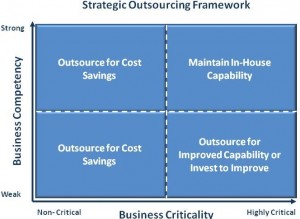Outsourcing – 5 tips for success
December 23rd, 2009Needless to say, the last two years have been difficult on companies of all sizes. Nowhere has this been felt more than by the internal IT organizations responsible for maintaining a company’s technology operations. With tight capital and reduced staffs most technology organizations have struggled to maintain the day to day with minimal focus on forward looking initiatives. One strategy that we see more companies exploring is the outsourcing of application management and technology operations. While hardly a new strategy, many companies are being driven to consider it for the first time due to current business conditions. While there are numerous horror stories of outsourcing initiatives gone bad, here are 5 things companies should do to put them on the path to success.
Establish a governance model – A governance model creates the framework under which you are going to manage the ongoing outsourcing relationship. It should address areas such as performance metrics, issue remediation, introduction of new technologies and processes, staffing, and problem management. While this list is not complete, it gives you an idea of what needs to be addressed. One critical point here is that this is not an IT only exercise. The biggest mistake a company can make here is not including business or functional owners, executives, and in some cases board members in the creation and approval of the governance model.
Know who you are outsourcing to – There are outsourcing firms of all sizes from niche providers to global organizations and none of them are invincible to troubles as we saw earlier in 2009 with Satyam one of the Indian outsourcing firms. You need to perform due diligence on the company before you sign any type of agreement. The due diligence should cover areas such as financials, operations, growth and expansion plans, and staffing plans. A key question to ask is how will they operate if growth or financial plans are not met.
Consolidate initiatives – Outsourcing is difficult enough to manage without having to manage a bevy of outsourcing providers with different metrics, measures, processes, and contracts. Also, by consolidating all of your initiatives to one or two vendors you can gain scale economies that will bring cost benefits to your organization. In the past we outsourced maintenance and development activities to one firm as the primary provider and then had a second firm perform small projects so that a) they became familiar with our system and to our people and b) it kept our primary provider on their toes.
Start small – Unless you are very experienced with managing outsourcing initiatives and have a provider working with you, start with smaller initiatives. It allows you to work through the governance model with a manageable project. As you successfully deliver you can roll into more projects or multiple efforts simultaneously.
Outsource what you know – The initial reaction to outsourcing is to unload that system that nobody understands and that always breaks. Unless it is a 3rd party package and your outsourcer has tremendous experience with it, this is a big mistake. At one company I worked at, we outsourced an HR function hoping to learn ‘best practices’ from the vendor since they were working with so many companies on this. Needless to say it didn’t work out as we thought. You need to know what you are outsourcing so you can manage the relationship, establish the metrics and measures, and hold your partner accountable.
Outsourcing is by no means a trivial initiative and things will go left when you want them to go right. It is inevitable. By putting these 5 tips into action you greatly increase your odds of having a successful outsourcing experience.

